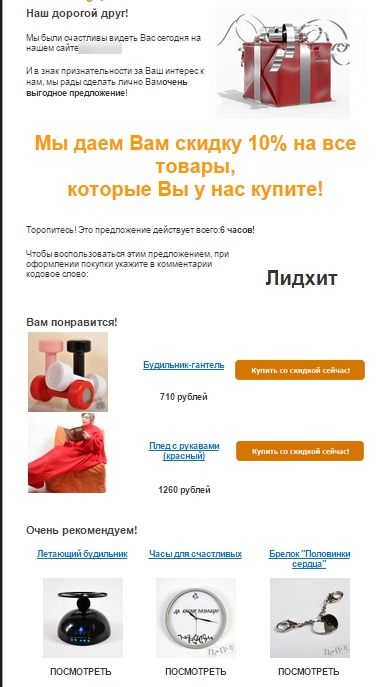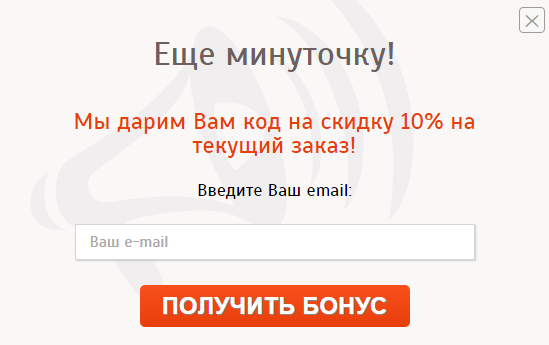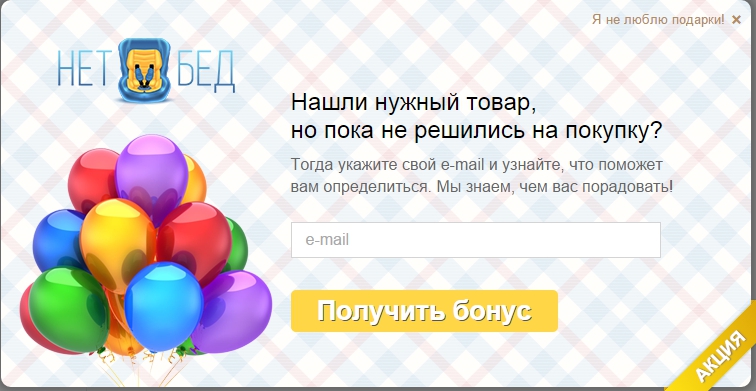Adventures pop-up in RuNet or 4 years of our practice
In this article I will talk about how our company began to implement services based on pop-ups and what came of it. The article will be useful to those who offer pop-ups or are going to do it, and will help those who doubt whether it is worth using such algorithms to make a decision.
A bit of history
Initially, in 2011, Leadhit was created as a marketing platform for the type of Western HubSpot. After six months of development, we realized that it would be very difficult to sell this idea; the market does not yet understand why such services are needed. Then we made the first pivot, turning into a service of "smart mailings", which quickly segmented the audience based on the history of the visit and allowed the visitor to make a specific offer using email distribution.
')
In the first version of the pop-ups and it was not. The idea was to offer the market a convenient and effective tool for identifying visitors 'interests on the site and then developing email-companies on a segmented base, taking into account the following parameters: visitors' interests to product groups, making a purchase or lack thereof, visitor activity, frequency of purchases and visits and much more. However, this good idea failed miserably. We could not sell? The market did not want to buy? Not ready to answer these questions. Communicating with marketers, we realized that they didn’t want a tool with which they needed to work independently, but a ready-made solution. Which is guaranteed to bring results, but there is no need to do anything. It is curious that only in 2015 did the tools that we tried to implement in that distant 2012 begin to appear on the market.
But I want to eat and had to invent further. We made the second pivot and the first widget appeared: a subscription form. But even here, there were no side effects - she only collected email and interfered with everything. The percentage of filling was high, but for some visitors the pop-up window was irritating with its intrusiveness, and the collected emails were poorly converted into orders. And then at the end of 2012, the “Last Hope Banner” appeared, now called “Smartoffer”, which combined two tools - widgets and relevant trigger mailings.
So everything looked in 2012:
 alt = "image" />
alt = "image" />
This is a pop-up at the exit from the site (exit intent), with the condition not a perfect purchase.
After that, visitors received such a letter. Do not judge strictly - we know its disadvantages ourselves. To the minuses it was possible to attribute the terms of dispatch - it arrived only after 20 minutes.

There were some minor problems - the banner was not periodically displayed, as the counter and the picture were heavy. And the display algorithms as a whole left much to be desired, there were practically no settings, it was not possible to adapt the banner for a specific site. In addition, adblock and adguard did not immediately fall in love with us, and yandek.market, as it turned out, is not at all pleased with this behavior on sites. And the duration of letter delivery reduced the number of orders. But there were advantages to achievement. The letter contained goods that the recipient was interested in on the site. This was the very functional component of the original idea. In addition, we changed the name - the original “Banner of the last hope” turned into a “Smart Offer”, which went to the benefit of the product, because now it was not perceived as a pop-up, and it became easier to sell the idea.
However, sales have become both easier and more difficult. Some potential customers perceived our service as a “boxed product”, which does not require much attention and care and brings results. For the rest, it was “pooh, pop-up.” However, with all the obvious advantages of this tool, even today we are faced with this attitude.
On the results: despite all the difficulties, we managed to increase sales to a number of key customers by 10%. And this is only at the start of the service, when it was still raw. The number of completed forms, on the basis of which the subscriber base was formed, also pleased.

What happened next: we did a lot of work on display algorithms, counter optimization, speed of its return, on pictures and layout of widgets, their weight and correctness, and also found a solution for Yandex.market, put up letter mock-ups, optimized reporting and clickability of letters, and so on .P.

Eventually:
Widgets were adapted for sites, the download speed of the counter and pictures was hundredths of a second, adblock and adguard get along well with us, Yandex.Market no longer makes comments to our customers, letters arrive almost instantly after sending the form, and they themselves have become almost perfect.
What has changed in the statistics
If we start from statistics on one of our best projects, we can justly be proud of the long and successful path we have taken over the years. Today, efficiency is 27% increase in the number of transactions. And this is due to "fu, pop-apu."
An important moment - the motivation in the letters. We have been thinking about this point for a long time. The call of the recipient to return to the site clearly must be accompanied by a promise of some kind of benefit. Discount in% or rubles, gift, free delivery, money on a mobile phone account - which is better? But after several years of practice, we realized that there is no universal recipe. You just need to test and select. For the same segments, we had completely different indicators with absolutely identical incentives and actions. We must try and look for the best, and periodically change the concept.
Findings:
Working with pop-ups is not the easiest niche and line of business. However, in this direction you can live and develop, and with the right settings and competent approaches, you can achieve excellent results. For 2 years of development of this direction have done:
• The display algorithm virtually eliminates the possibility of “cannibalism” and is as loyal as possible.
• Complaints about obsession stopped. On average, we show banners for 20-30% of visitors - exclusively interested, without causing irritation to the rest of the audience. Although, in connection with this, the percentage of form filling has decreased, but the percentage of conversion has increased due to the demonstration of widgets to the target audience.
• Letters arrive quickly, contain relevant products and look as attractive as possible and are composed in accordance with the criteria of the “ideal letter” (we continue to work on this).
We shared our experience, which can be useful primarily to those who want to sell services related to pop-ups. Before you start such a service, consider how, to whom and why to show pop-ups. What happens after clearance. And let this “after registration” be of better quality.
A bit of history
Initially, in 2011, Leadhit was created as a marketing platform for the type of Western HubSpot. After six months of development, we realized that it would be very difficult to sell this idea; the market does not yet understand why such services are needed. Then we made the first pivot, turning into a service of "smart mailings", which quickly segmented the audience based on the history of the visit and allowed the visitor to make a specific offer using email distribution.
')
In the first version of the pop-ups and it was not. The idea was to offer the market a convenient and effective tool for identifying visitors 'interests on the site and then developing email-companies on a segmented base, taking into account the following parameters: visitors' interests to product groups, making a purchase or lack thereof, visitor activity, frequency of purchases and visits and much more. However, this good idea failed miserably. We could not sell? The market did not want to buy? Not ready to answer these questions. Communicating with marketers, we realized that they didn’t want a tool with which they needed to work independently, but a ready-made solution. Which is guaranteed to bring results, but there is no need to do anything. It is curious that only in 2015 did the tools that we tried to implement in that distant 2012 begin to appear on the market.
But I want to eat and had to invent further. We made the second pivot and the first widget appeared: a subscription form. But even here, there were no side effects - she only collected email and interfered with everything. The percentage of filling was high, but for some visitors the pop-up window was irritating with its intrusiveness, and the collected emails were poorly converted into orders. And then at the end of 2012, the “Last Hope Banner” appeared, now called “Smartoffer”, which combined two tools - widgets and relevant trigger mailings.
So everything looked in 2012:
 alt = "image" />
alt = "image" />This is a pop-up at the exit from the site (exit intent), with the condition not a perfect purchase.
After that, visitors received such a letter. Do not judge strictly - we know its disadvantages ourselves. To the minuses it was possible to attribute the terms of dispatch - it arrived only after 20 minutes.

There were some minor problems - the banner was not periodically displayed, as the counter and the picture were heavy. And the display algorithms as a whole left much to be desired, there were practically no settings, it was not possible to adapt the banner for a specific site. In addition, adblock and adguard did not immediately fall in love with us, and yandek.market, as it turned out, is not at all pleased with this behavior on sites. And the duration of letter delivery reduced the number of orders. But there were advantages to achievement. The letter contained goods that the recipient was interested in on the site. This was the very functional component of the original idea. In addition, we changed the name - the original “Banner of the last hope” turned into a “Smart Offer”, which went to the benefit of the product, because now it was not perceived as a pop-up, and it became easier to sell the idea.
However, sales have become both easier and more difficult. Some potential customers perceived our service as a “boxed product”, which does not require much attention and care and brings results. For the rest, it was “pooh, pop-up.” However, with all the obvious advantages of this tool, even today we are faced with this attitude.
On the results: despite all the difficulties, we managed to increase sales to a number of key customers by 10%. And this is only at the start of the service, when it was still raw. The number of completed forms, on the basis of which the subscriber base was formed, also pleased.

What happened next: we did a lot of work on display algorithms, counter optimization, speed of its return, on pictures and layout of widgets, their weight and correctness, and also found a solution for Yandex.market, put up letter mock-ups, optimized reporting and clickability of letters, and so on .P.

Eventually:
Widgets were adapted for sites, the download speed of the counter and pictures was hundredths of a second, adblock and adguard get along well with us, Yandex.Market no longer makes comments to our customers, letters arrive almost instantly after sending the form, and they themselves have become almost perfect.
What has changed in the statistics
If we start from statistics on one of our best projects, we can justly be proud of the long and successful path we have taken over the years. Today, efficiency is 27% increase in the number of transactions. And this is due to "fu, pop-apu."
An important moment - the motivation in the letters. We have been thinking about this point for a long time. The call of the recipient to return to the site clearly must be accompanied by a promise of some kind of benefit. Discount in% or rubles, gift, free delivery, money on a mobile phone account - which is better? But after several years of practice, we realized that there is no universal recipe. You just need to test and select. For the same segments, we had completely different indicators with absolutely identical incentives and actions. We must try and look for the best, and periodically change the concept.
Findings:
Working with pop-ups is not the easiest niche and line of business. However, in this direction you can live and develop, and with the right settings and competent approaches, you can achieve excellent results. For 2 years of development of this direction have done:
• The display algorithm virtually eliminates the possibility of “cannibalism” and is as loyal as possible.
• Complaints about obsession stopped. On average, we show banners for 20-30% of visitors - exclusively interested, without causing irritation to the rest of the audience. Although, in connection with this, the percentage of form filling has decreased, but the percentage of conversion has increased due to the demonstration of widgets to the target audience.
• Letters arrive quickly, contain relevant products and look as attractive as possible and are composed in accordance with the criteria of the “ideal letter” (we continue to work on this).
We shared our experience, which can be useful primarily to those who want to sell services related to pop-ups. Before you start such a service, consider how, to whom and why to show pop-ups. What happens after clearance. And let this “after registration” be of better quality.
Source: https://habr.com/ru/post/293480/
All Articles